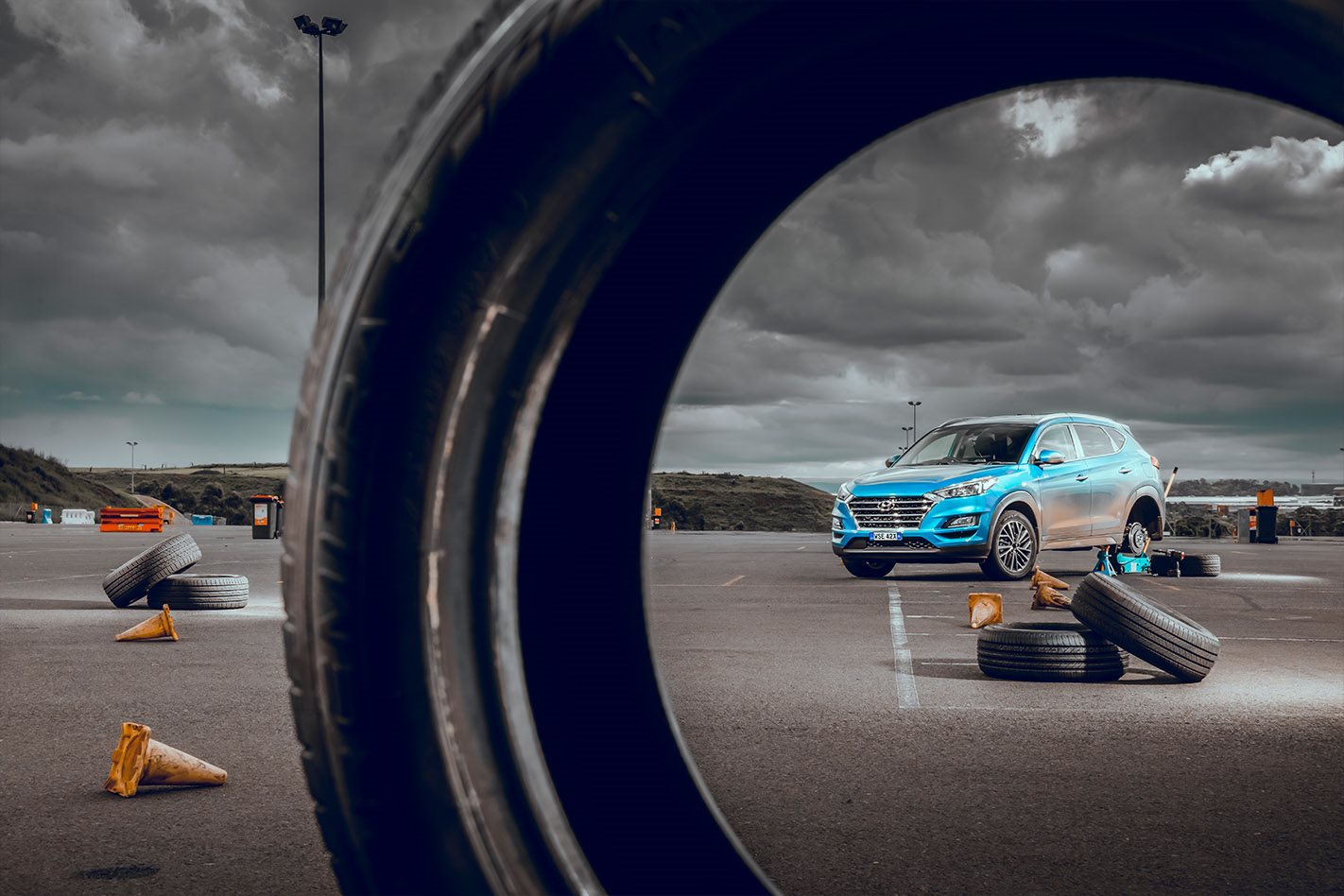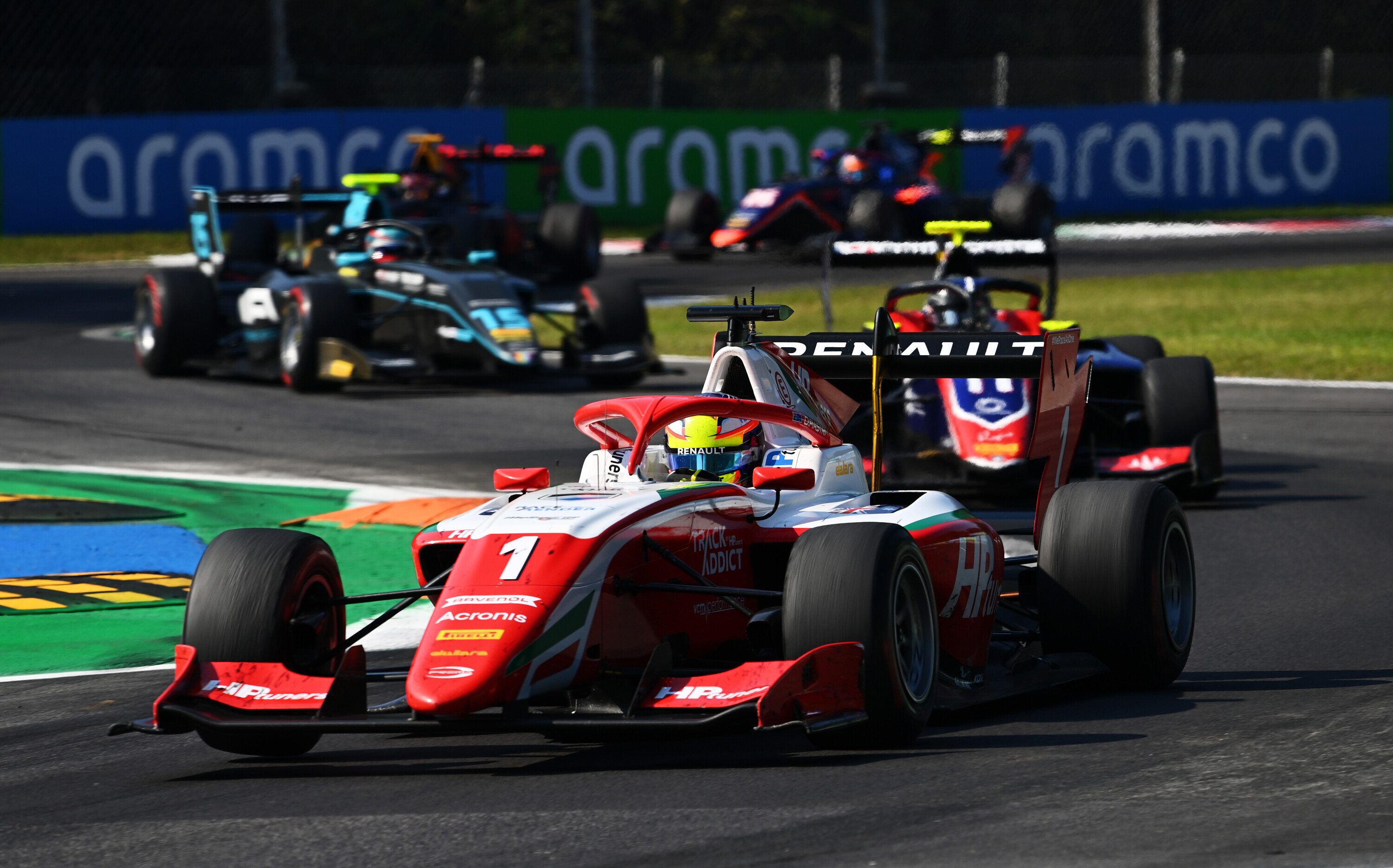It’s not quite the truck full of cash anyone ticking their Lotto boxes dreams of backing up to their front gate, but the sight of a Tyreright truck door peeling open to reveal a large mound of fresh rubber is enough to get any car enthusiast tingly in the right foot.
Welcome to the Wheels Tyre Test 2020, where peak Gs, single centimetres and flying orange cones aim to test the mettle of the best rubber out there.
- What tyres are we testing?
- What car is being used?
- Who is doing the driving?
- How is everything being handled?
- How much do the tyres cost?
- Tyre treads
- Tyre weights
- Test #1: Slalom
- Test #2: Dry braking
- Test #3: Dry cornering
- Test #5: Wet braking
- Test #6: Wet cornering
- Test #7: Tyre noise
- Overall winner
The stack of tyres alongside the Tyreright truck looks more like we’re gearing up for a tilt at the Bathurst 12 Hour, albeit with more grooves than your average GT3 car would fancy. Ten stacks of still-glistening rubber add to the darkness of the sky. Yet our locale – a makeshift track in a western Sydney car park – is very different to the up and down of Mount Panorama. And our weapon of choice, a humble Hyundai, is far from lap ready.
As any enthusiast (or racer) will tell you, tyres are one of the most important components of any new car. It doesn’t matter how many kilowatts those rear tyres can throw out if they can’t make it to Mother Earth.
For this year’s test we aimed high; SUV high, in the form of a Hyundai Tucson. But the rubber was a respectable 225mm wide with a 55 profile and an 18-inch diameter. It’s a popular size with many mid-size SUVs. Plus, there are dozens of options from more than 20 brands, 10 of which lined up for our day of scrutiny.
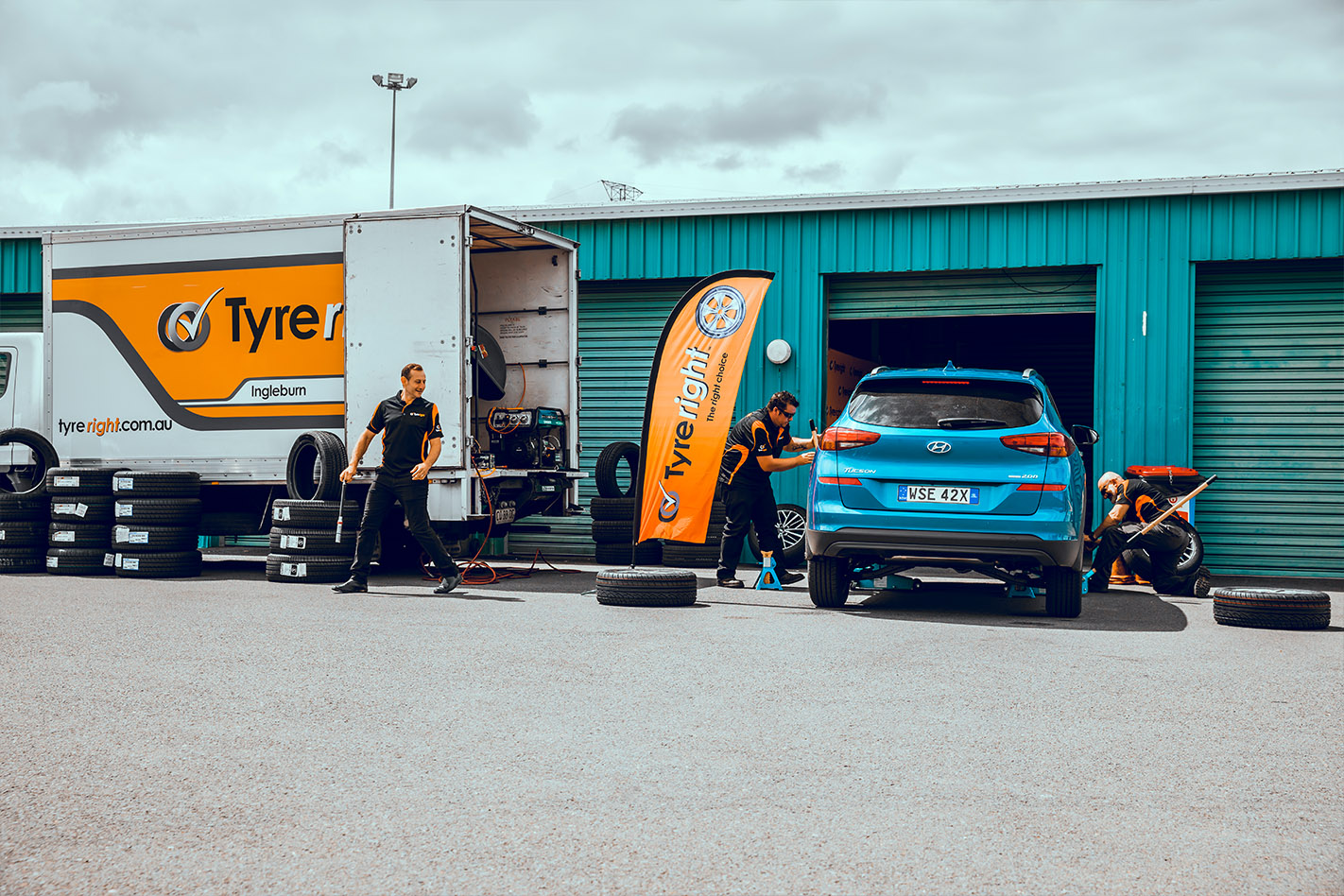
Our testing involves a little over 10 kilometres of brutality few tyres are likely to experience in their tens of thousands of kays rolling over freeways, suburban streets and the occasional rural back road. We’ll test everything other than puncture resistance, impact on fuel economy and how long they’re likely to last.
The Tyreright crew dutifully ensures the day rolls smoothly.
Before any data is collected there are some early swerving and sliding manoeuvres to get the moulding compound off the surface. The initial lack of grip on a brand-new set can provide some freckle-tightening moments if you don’t have the expanse of a skidpan at your disposal. Then it’s an 80km/h noise-reading on exactly the same piece of blacktop, the tranny in neutral to place the emphasis on what’s going on at ground level.
Then the fun stuff, which consists of five on-the-limit disciplines. Cornering and braking in the dry kick things off before a slalom. Out comes the water truck to ensure appropriate slickness for wet cornering and braking.
Each discipline is repeated up to three times, until our wheel man Renato is confident he’s driven the tyres to their maximum. The entire test sequence is over in less than 15 minutes, formerly fresh hoops scuffed and stuffed like they’ve seen a lap (or two) with Daniel Ricciardo.
Data is taken using a satellite-based VBox with video recording to confirm any excursions or check wayward results. We also interrogate Renato as to what he liked – and didn’t. It doesn’t count on the scorecard, but can give context to the result and help explain why one tyre performed better than another. To Renato they’re just ‘set one’ or ‘set two’. He gets into the car not knowing what’s been bolted on by our Tyreright pit crew.
With times taken and data processed, each tyre is given a percentage score relative to the best performer, which picks up a perfect 100. Then it’s deep into spreadsheets and number crunching to work out which excels, and where. Very few nail each discipline, but some score highly across the board. Others pinnacle in one or another but leave wheels spinning elsewhere.
From the rush of the track to a finish-line dash for glory that often comes down to a single centimetre, the Wheels Tyre Test 2020 shines the spotlight on the compromises in pursuit of creating the perfect round black things. Which, after copious sliding and scrubbing, we can confirm still doesn’t exist.
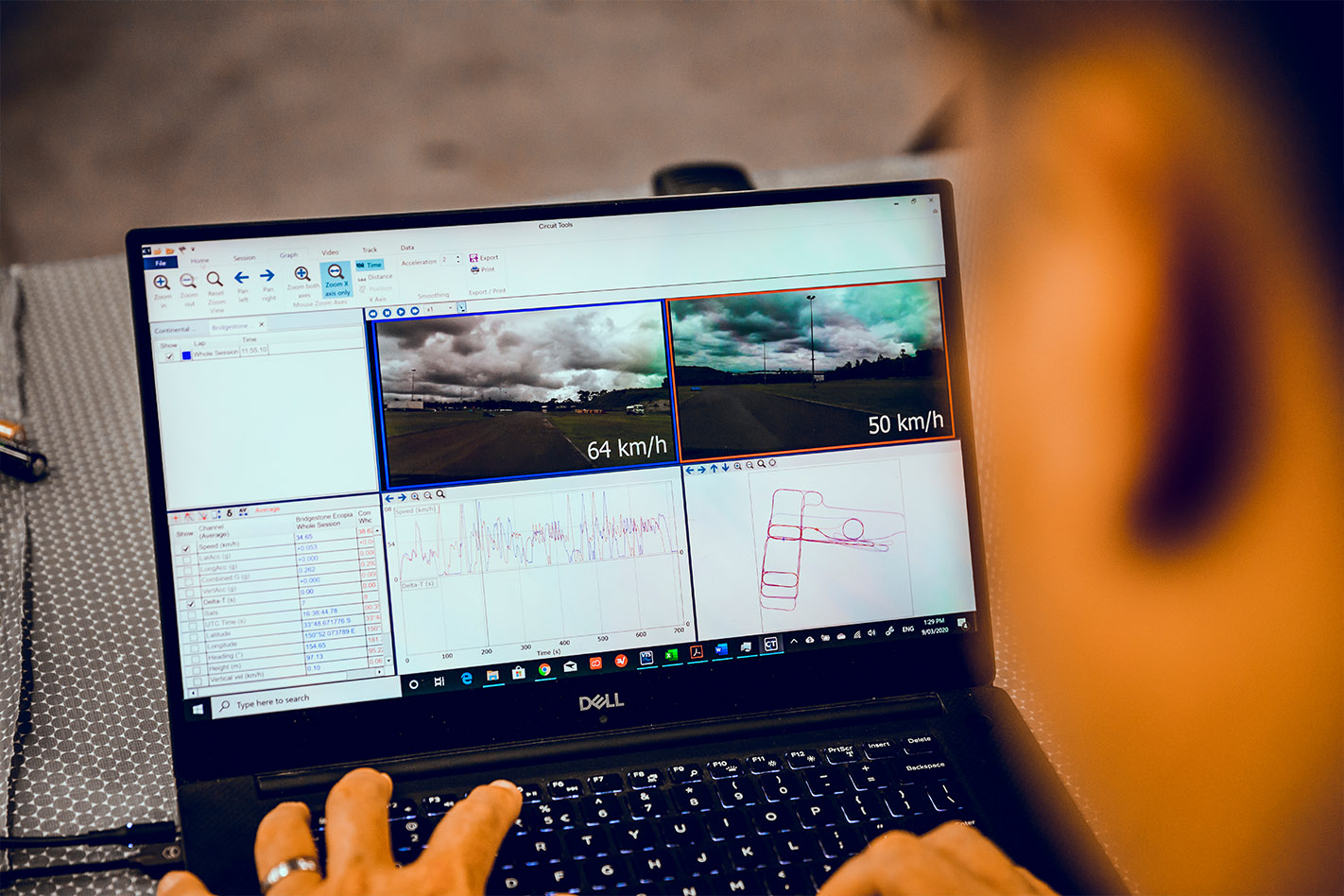
What tyres are we testing?
This year’s 10-strong field comprises a strong mix of well-known brands such as Bridgestone, Continental (x2) and Cooper, with relative newbies like Giti and Hifly. Making up the middle ground are rapidly improving players such as Toyo, Hankook, Kumho and Maxxis. Missing from this year’s starting grid are Michelin and Yokohama, who don’t supply tyres for independent tests, and Pirelli and Falken who declined to take part. Goodyear and Dunlop couldn’t provide tyres in time for testing.
- Bridgestone Ecopia H/L 001
- Continental PremiumContact 6
- Continental UltraContact UC6 SUV
- Cooper CS5 Grand Touring
- Giti Control SUV880
- Hankook Dynapro HP2
- Hifly Vigorous HP801
- Kumho Crugen Premium
- Maxxis Premitra 5
- Toyo Proxes C100 Plus SUV
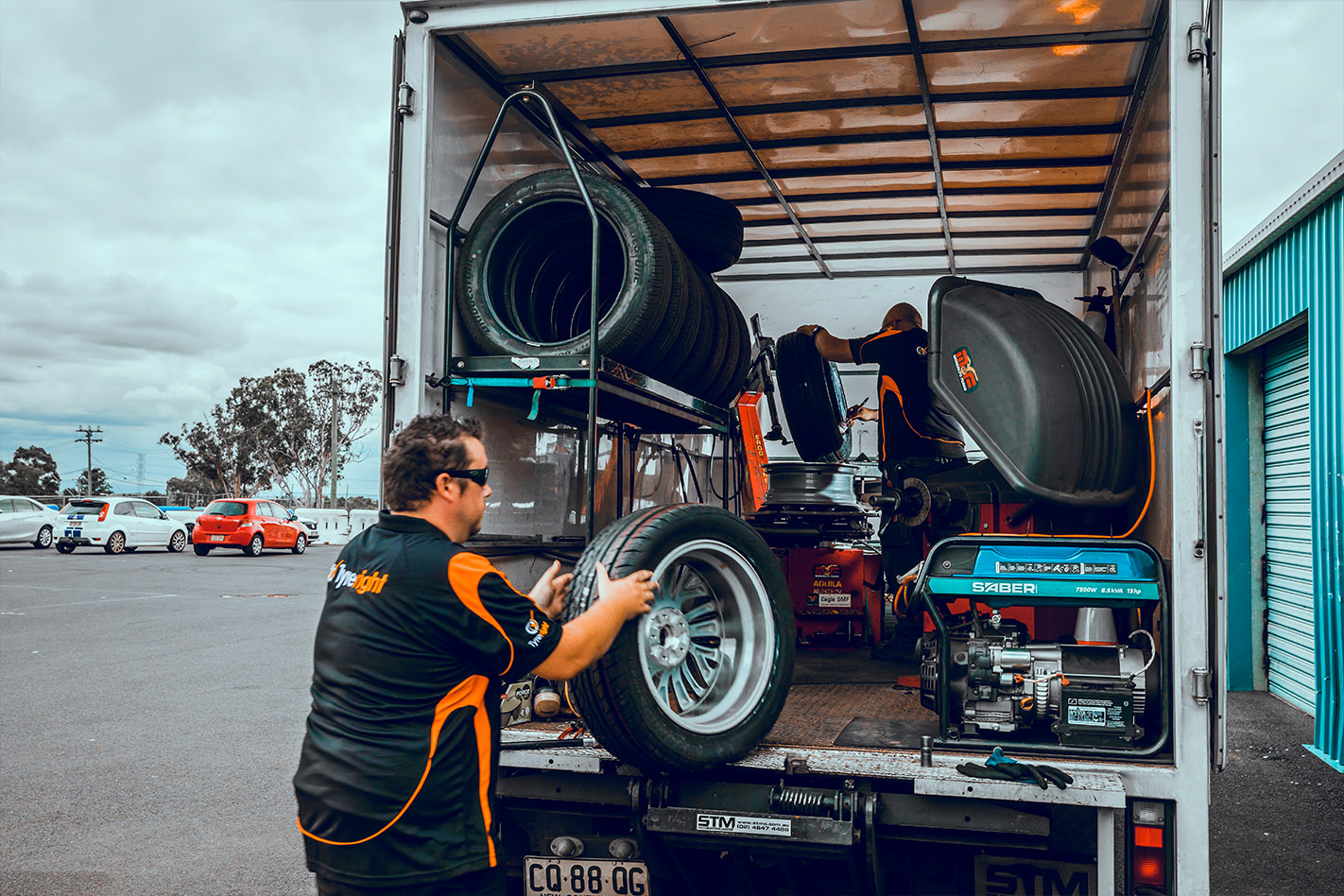
What car is being used?
Our weapon of choice is the Hyundai Tucson, one of the top-selling mid-size SUVs on the market. That it’s also a respectable handler made it a perfect proposition for Tyre Test 2020.
Ours was a Highlander diesel on 18-inch alloys that look as though they’d take three days to clean.
It’s also had some electrical tweaks from whizz Hyundai engineer Pete to ensure the data we’re collecting is about tyres, not electronics.
All testing is with tyres at 35psi, the placard-recommended pressure for an unladen Tucson.
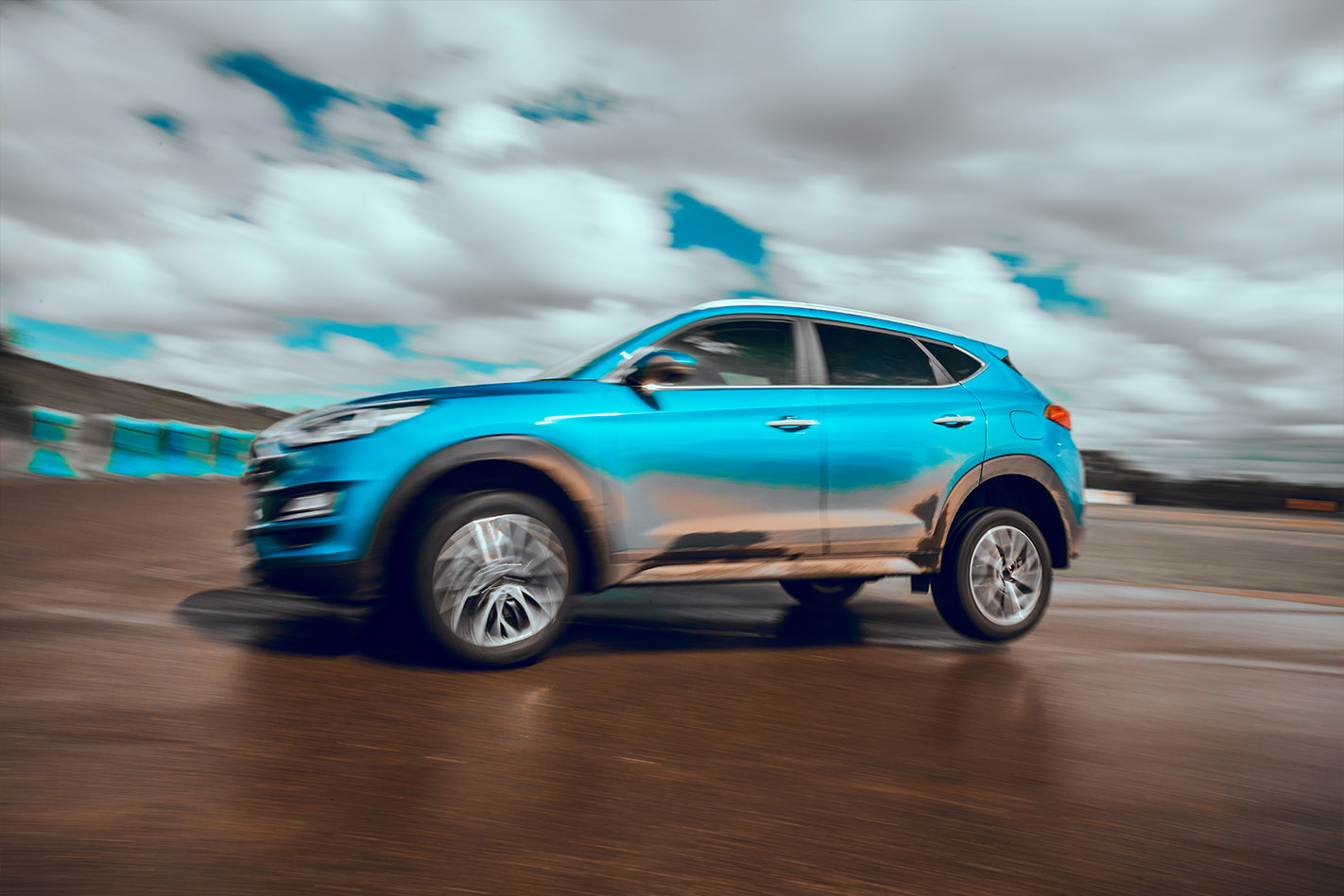
Who is doing the driving?
OCD isn’t always a good thing on a Wheels test, but when Renato Loberto starts talking tyres he quietly admits he wants to run over exactly the same knobble of bitumen every time and ensure the wet section has the same carefully metered splash of H20.
That’s good because it means he’ll do the same thing every time. Consistency is critical on a tyre test.
Renato, 39, may be more at home in a race car – like the Ferrari 458 GT3 he raced in the Bathurst 12 Hour in 2016 – but he’s also damn fine doing hot laps in a family SUV.
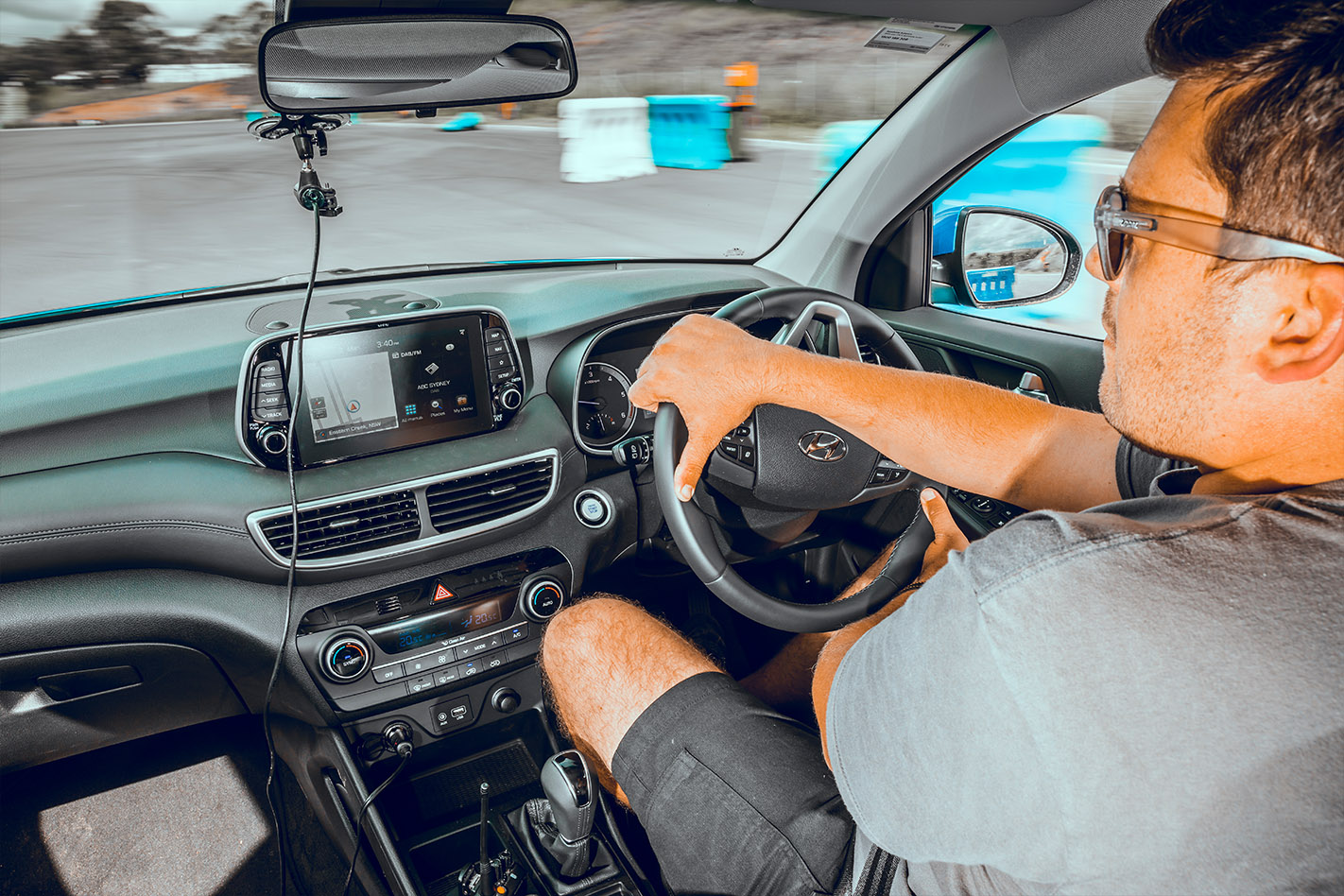
How is everything being handled?
Something north of 60 tyre changes in a day would be sweaty work for anyone, but our trusty team at Tyreright nailed it every time.
Within minutes of Renato rolling into our makeshift pits, the car was ready for the next level of punishment.
Without this level of efficiency and expertise, it’s likely we’d still be there fiddling with tyre irons.
With more than 70 stores across all states and territories, Tyreright is not aligned to any particular brand (unlike some of its rivals), instead offering a broad range of tyres to suit your needs.
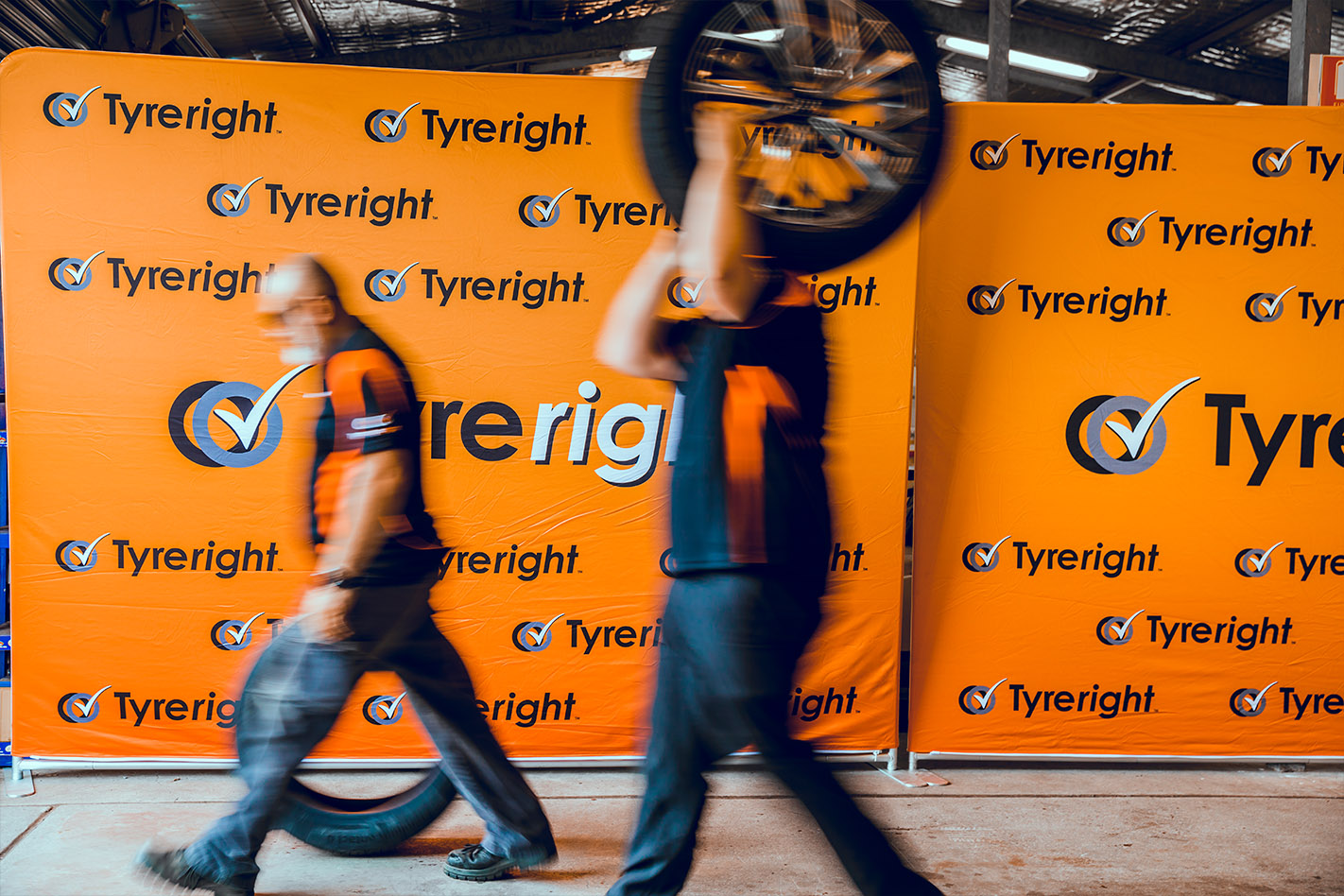
How much do the tyres cost?
With an average price of $263 per tyre, there’s a big spread on test.
The prices we’ve listed here are RRP and are rarely what you’ll pay once you start sniffing around for a deal.
While there’s a big difference between the cheapest and most expensive – a hefty $190 per tyre – the ‘real’ difference is much slimmer.
On the day we checked online we could get the $350 Bridgestones for $256, a saving of $376 for a quartet.
While tricky to find, the cheapest Hiflys were around $130 a tyre, a saving of around $120 for a set of four.
- Bridgestone Ecopia H/L001: $350
- Hankook Dynapro HP2: $310
- Cooper CS5 Grand Touring: $294
- Continental UltraContact UC6 SUV: $290
- Toyo Proxes C100 Plus SUV: $270
- Continental PremiumContact 6: $260
- Giti Control SUV880: $255
- Maxxis Premitra 5: $240
- Kumho Crugen Premium: $200
- Hifly Vigorous HP801: $160
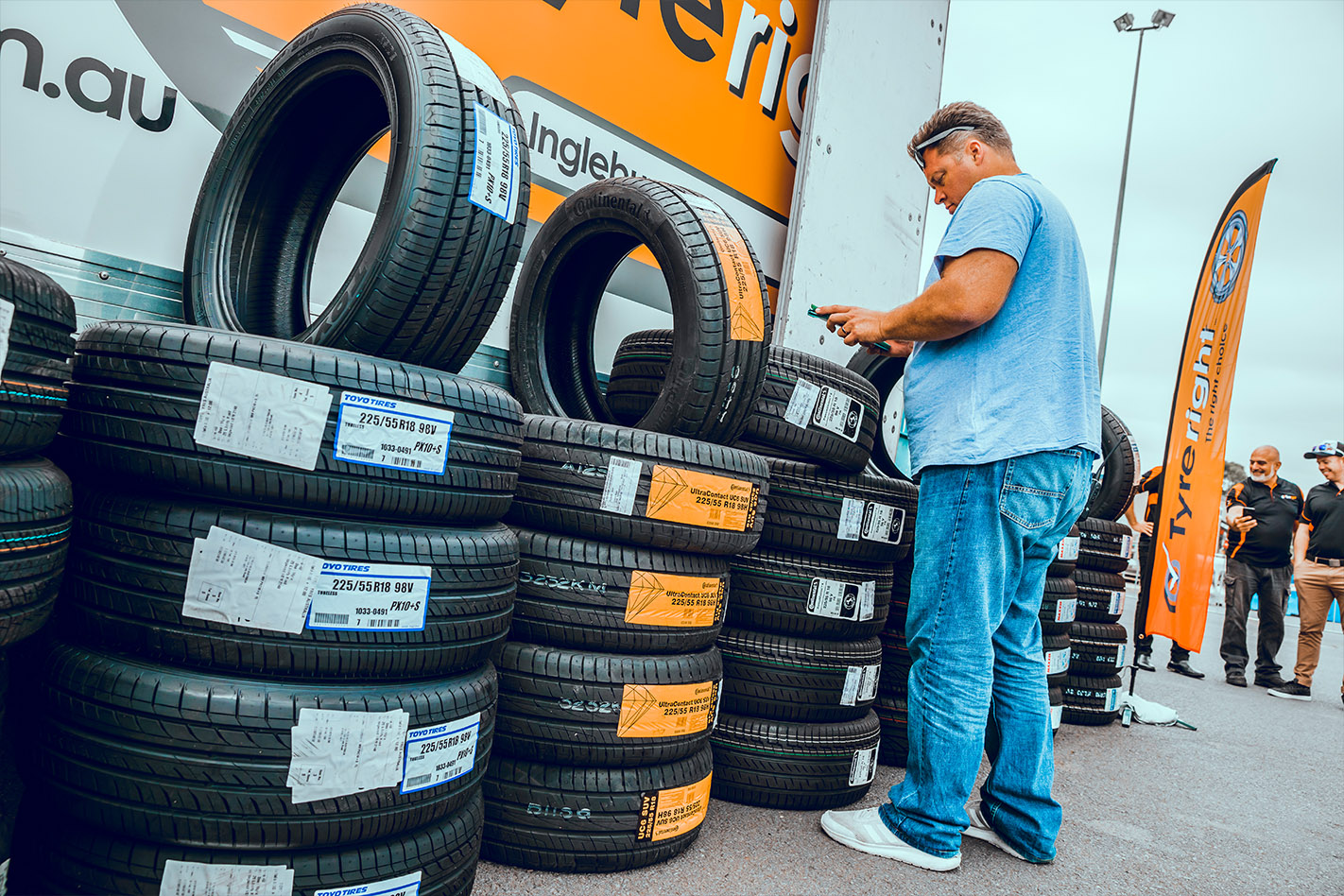
When it comes to tyre tread, more isn’t always better
Deeper tread grooves mean height for each tread block, which often means more movement, in turn affecting steering feel. It’s one reason those chunky mud-terrain tyres that dual-cab ute drivers insist on tearing around the suburbs on are so terrible on bitumen. But the more distance you’ve got between the carcass of the tyre and the actual tread surface, the more there is to wear away.
We checked the tread depths of our 10 contenders and noticed big differences. Many had deeper central grooves and shallower outer ones, so the figures you see here are for the deepest central section.
We’re only talking 1.1mm between best and worst, but when the deepest of the bunch is only 8.6mm deep, that’s a 13 percent difference. We also reckon it’s no coincidence that our top three – the Continental PremiumContact 6, the Maxxis and the Bridgestone – had the shallowest tread depths.
| Tyre | Max. tread depth |
| Cooper CS5 Grand Touring | 8.6mm |
| Hifly Vigorous HP801 | 8.4mm |
| Kumho Crugen Premium | 8.4mm |
| Toyo Proxes C100 Plus SUV | 8.3mm |
| Continental UltraContact UC6 SUV | 8.2mm |
| Hankook Dynapro HP2 | 8.0mm |
| Giti Control SUV880 | 8.0mm |
| Bridgestone Ecopia H/L001 | 7.9mm |
| Continental PremiumContact 6 | 7.5mm |
| Maxxis Premitra 5 | 7.5mm |
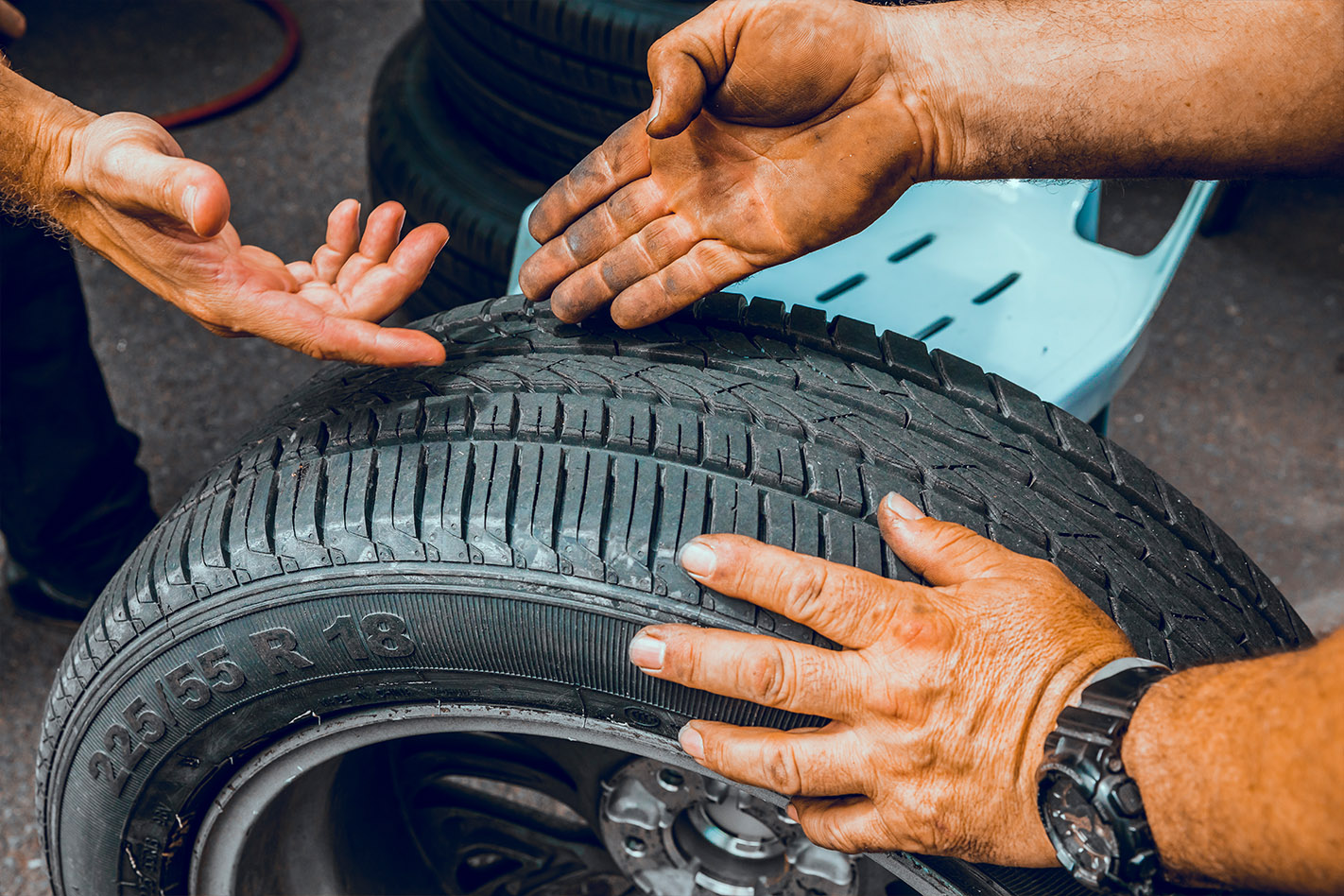
Yes, we even weighed the tyres
The dimensions of tyres are strictly controlled by the numbers written on the side. Our 225/55 18-inch test tyres had exactly 225mm of tread across their face and a sidewall that measured 55 percent of that, so theoretically, 124mm.
Not that you’d know it looking at our stacks of tyres. Variations in the sidewalls meant some were at least 10mm taller.
And dragging out the trusty scales showed the difference in weight between tyres varied to a much greater extent.
There was a two kilo difference – almost 19 percent – between the lightest of our contenders (Maxxis) and the heaviest (Giti). That additional heft – up to 8kg for a set of four hoops – negatively impacts unsprung weight.
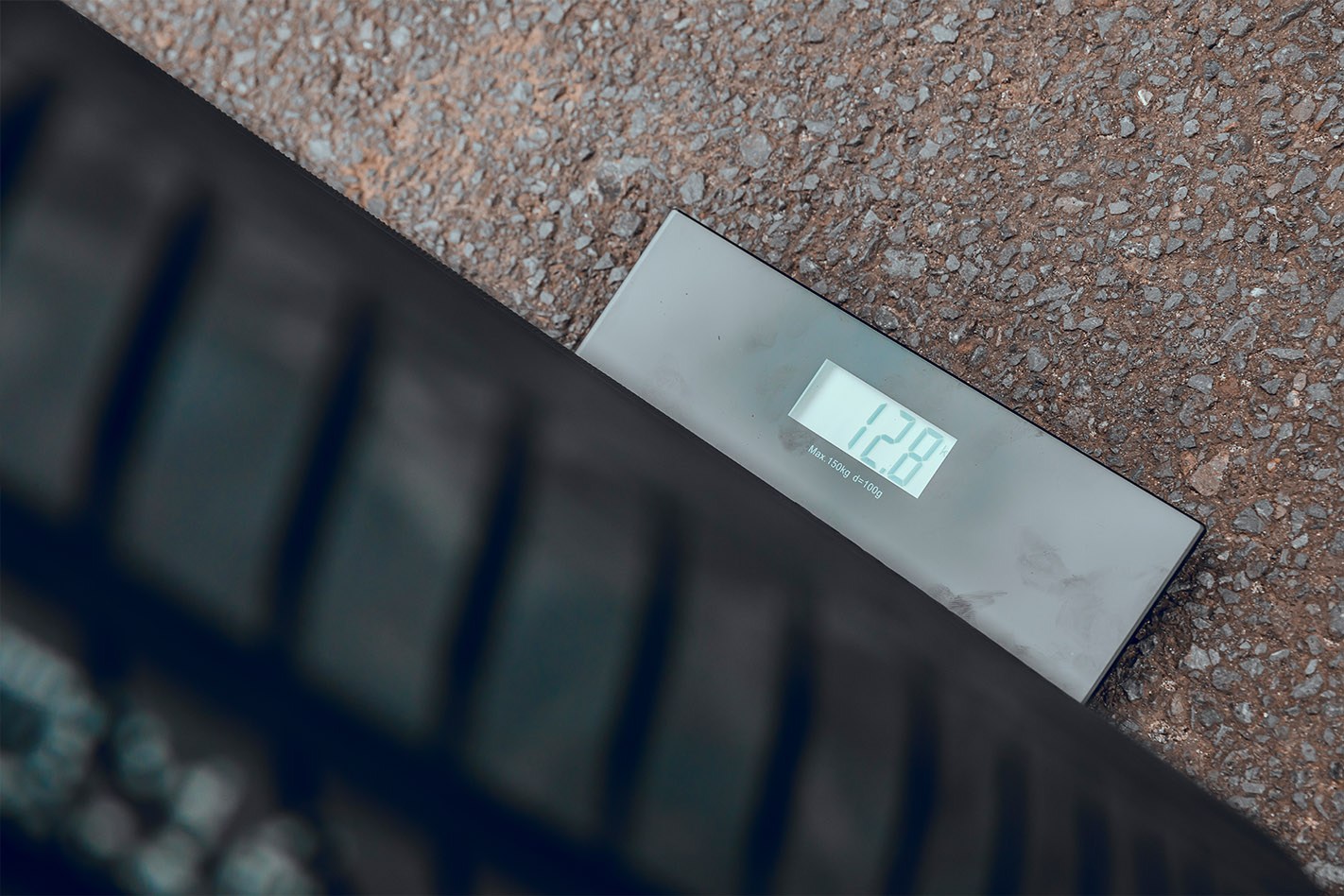
Test #1: Slalom
Grip is important but how well a tyre responds to quick direction changes is crucial to complete the performance picture. In around six seconds our slalom flip-flops each tyre from full lateral load in either direction five times.
Even setting it up had Renato excited at the thought, the slalom bringing seat-of-the-pants feel to tenths and hundredths of a second. There was no pacing out the cones to get them vaguely right. Instead it was out with the trundle wheel to ensure each was precisely 24 metres apart. Perfect for a circa-70km/h entry.
It’s a brutal test that occasionally kicks a Tucson wheel skyward – depending on how well the tyre is holding its shape and how well the compound is keying into the asphalt. More than any other test it also helps Renato learn about the construction of the tyre.
“It felt like I was picking up an inside rear,” said Renato of the Conti UltraContact, “which is telling me it has excellent grip. And the way it was progressively shifting the weight there was no slide or yaw moments happening in the tyre, which is quite impressive.”
The Bridgestone also impressed with its responses, albeit not as much with the stopwatch. “It’s a really responsive tyre to turn-in, which makes it feel like it’s got way more grip than it does,” said Renato.
The brand may be best-known for off-roading, but the Cooper is also a “very communicative tyre”, and one that scurried through our coney course third quickest.
Similarly, the Toyo received a rare “very, very good … and it felt like it had bucketloads of initial grip”, while the Giti was “so progressive … so it responded well”.
The Maxxis wasn’t looked upon so favourably, with Renato critical of its ability to change direction briskly. “The peak lateral grip just falls away instantly … it doesn’t have the ability in its construction to deal with the weight moving in that frequency.”
It’s perhaps no surprise the Maxxis is the lightest of our tyres, one possibly lacking copious steel belt firmness.
The Kumho floundered because “when you push it with any pace it would fall off immediately”, while the Hifly Vigorous was ironically pretty leisurely in recording the slowest time.
| Rank | Tyre | Time | Score |
| 1 | Continental UltraContact UC6 SUV | 5.76 | 100 |
| 2 | Continental PremiumContact 6 | 5.77 | 99.8 |
| 3 | Cooper CS5 Grand Touring | 6.07 | 94.6 |
| 4 | Toyo Proxes C100 Plus SUV | 6.14 | 93.4 |
| 5 | Giti Control SUV880 | 6.15 | 93.2 |
| 6 | Bridgestone Ecopia H/L001 | 6.23 | 91.8 |
| 7 | Kumho Crugen Premium | 6.28 | 91.0 |
| 8 | Hankook Dynapro HP2 | 6.31 | 90.5 |
| 9 | Maxxis Premitra 5 | 6.45 | 88.0 |
| 10 | Hifly Vigorous HP801 | 6.89 | 80.4 |
Slalom winner: Continental UltraContact UC6 SUV
“That felt like the best tyre by some margin,” Renato said after pitting on the PremiumContact Contis. “I was seeing higher peak slalom speeds … and it was super consistent. It’s very progressive and you get heaps of feel out of it.” But then along came the UltraContact, which just nerfed its sibling into second and cemented a slalom one-two for the brand. The Cooper took slalom bronze.
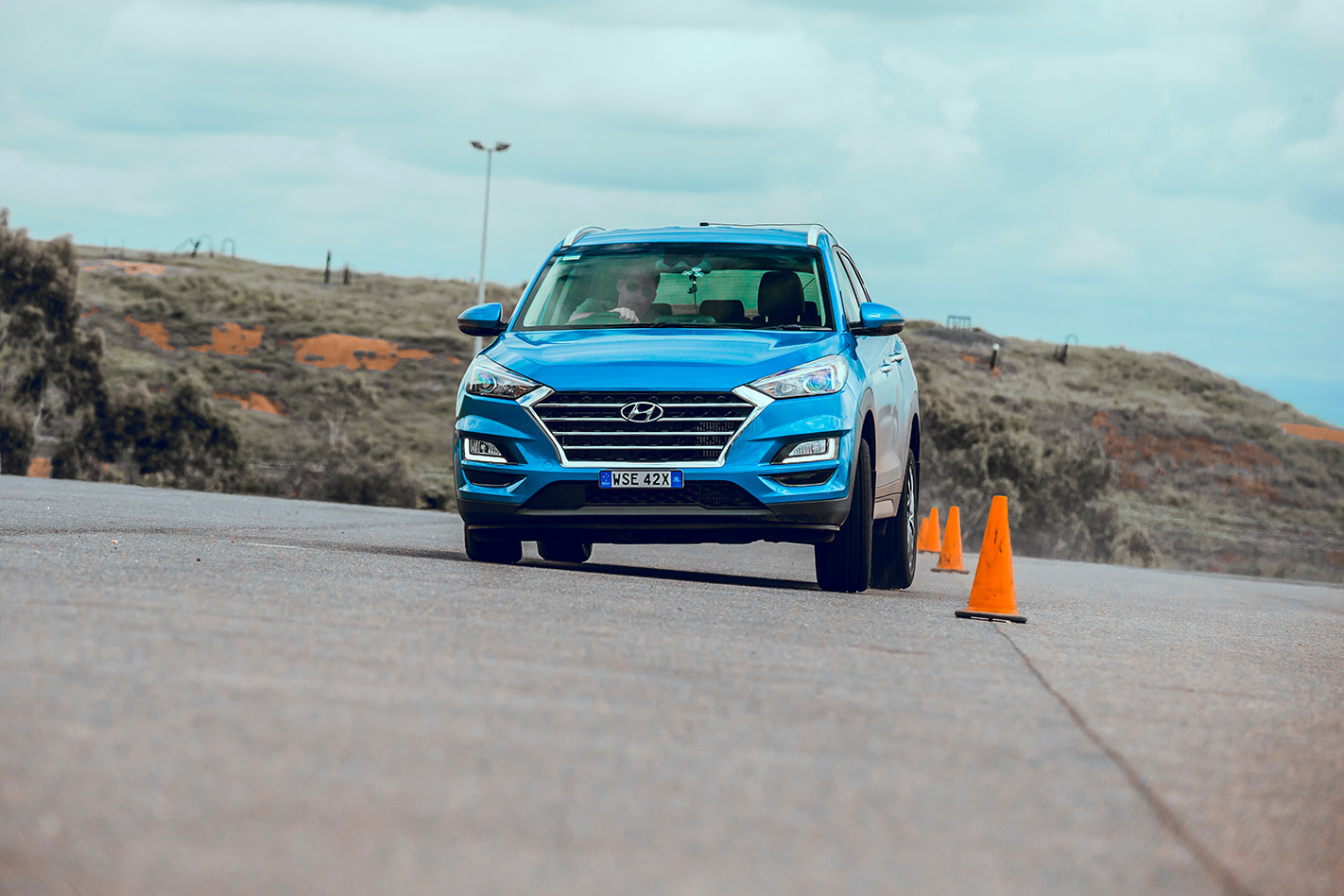
Test #2: Dry braking
Hauling out the anchors in a straight line should be fairly easy in a modern car; plant your right foot and let the ABS do its thing. But watching our cheapie Hifly try to arrest the pace of a hurtling Tucson was like a dog rushing in for a morning pat on freshly lacquered floorboards. The only vigorous thing was a wagging tail – and plenty of Renato wheelwork to keep things facing forward. And it wasn’t even the longest-stopping tyre.
“I was about to come in and ask if there were different tyres on either side,” he joked of what was a classic arm-crossing catch.
The braking test starts at 110km/h when Renato slams the brake pedal towards the firewall. By the time the Tucson is doing 100km/h the ABS is in full swing, leaving the tyres as the only variable between a change-of-undies moment and insurance forms. Between best and worst there’s more than a long-wheelbase S-Class in it, providing a stark reminder of the value of good boots.
Consistency also comes into play during 40-plus hard dry stops (four per tyre). While Renato liked the repeatability and front-to-rear balance of the Hankook, he was not entirely convinced by the stopping ability. “Even with the dry braking I was a fair way into it when I was pulling up,” he said. At a bumper or two past 45 metres, the Hankook was a clear tailrunner for dry braking.
The Kumho also performed poorly, although Renato felt there was good initial bite up front before the rears began locking early, keeping the ABS busy trying to sort things out.
At the pointy end, five tyres were separated by less than two metres.
Continental’s UltraContact maintained its excellent feel and stopped short of 41m, but it was still more than half a metre further than the Bridgestone. Renato liked third place getter Toyo, noting the initial grip was terrific, but it still couldn’t match the Conti PremiumContact. And he found the Maxxis made up for its lateral sloppiness with excellent braking performance. “Its longitudinal grip seems to be way better than when you tip into a corner.”
| Rank | Tyre | Distance | Score |
| 1 | Maxxis Premitra 5 | 39.00 | 100 |
| 2 | Continental PremiumContact 6 | 39.48 | 98.8 |
| 3 | Toyo Proxes C100 Plus SUV | 40.20 | 96.9 |
| 4 | Bridgestone Ecopia H/L001 | 40.34 | 96.6 |
| 5 | Continental UltraContact UC6 SUV | 40.91 | 95.1 |
| 6 | Hifly Vigorous HP801 | 41.18 | 94.4 |
| 7 | Cooper CS5 Grand Touring | 42.16 | 91.9 |
| 8 | Giti Control SUV880 | 42.28 | 91.6 |
| 9 | Kumho Crugen Premium | 43.83 | 87.6 |
| 10 | Hankook Dynapro HP2 | 45.87 | 82.4 |
Dry braking winner: Maxxis Premitra 5
For a tyre that performed averagely elsewhere, the Maxxis is a scorcher if you have to wash off speed – in a straight line, at least. But it was the Continental PremiumContact that delivered a better feel and still exceptional stopping (albeit almost half a metre further up the road than the Maxxis). “Really, really good braking. Good initial brake feel and consistent,” said Renato. The Toyo took third.
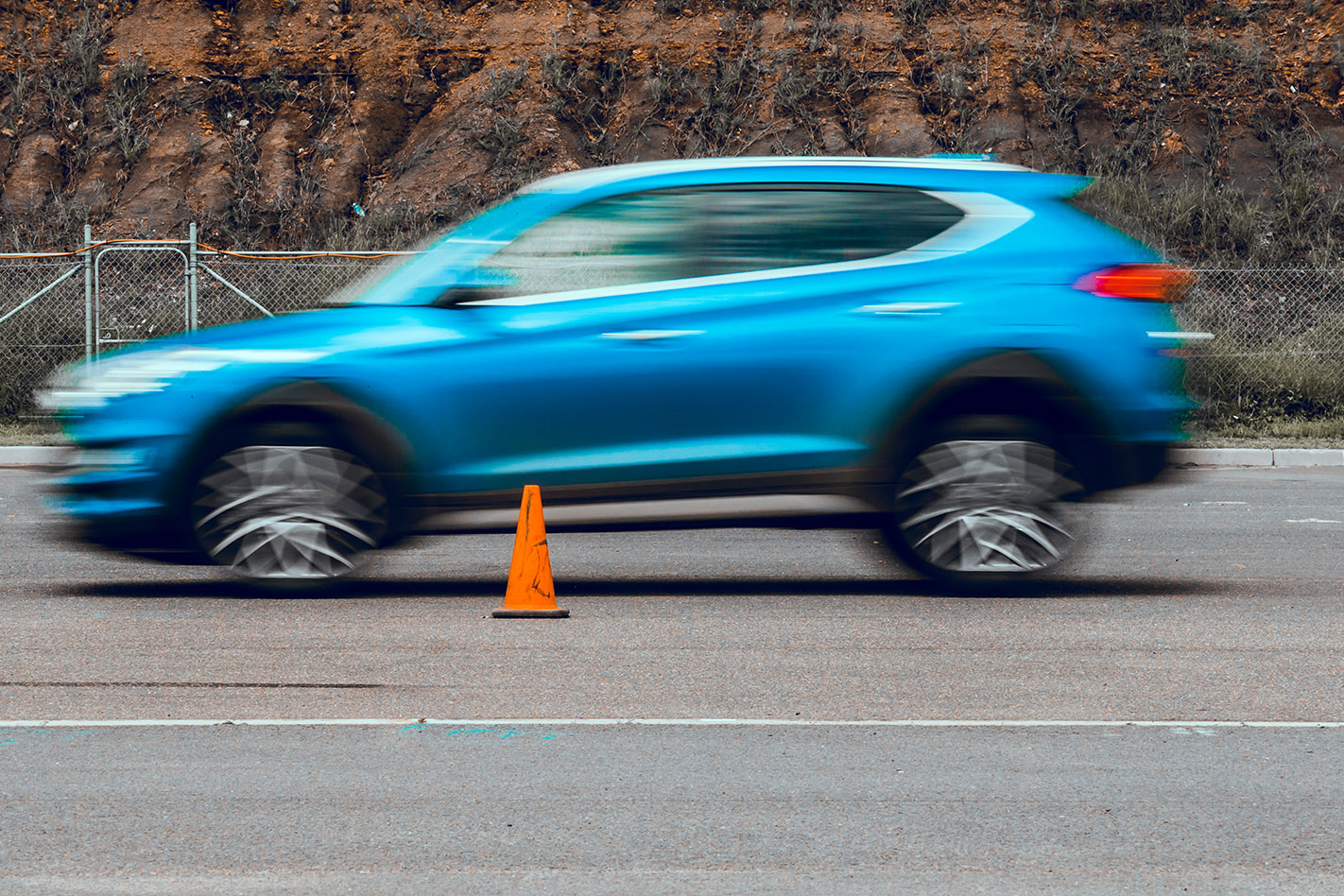
Test #3: Dry cornering
Specific tyre selection when tackling our two brisk 90-degree corners and a 50km/h constant-radius circle can make the difference between a wayward Tucson and a well-behaved one. Between the trio of bends that makes up our dry cornering assessment there’s 20 seconds of on-the-limit squealing to give us a great idea of tyre tenacity.
That constant circle also allowed Renato to lean on the tyre persistently to better understand what it was doing and how it coped with repeated extremes. In the case of the Kumho, it couldn’t handle the punishment. “The grip would just disappear,” said Renato. Little wonder it finished dead last.
But the Cooper CS5 Grand Touring surprised. It was quickest through one of the three disciplines – by just 0.02 seconds –- something Renato puts down to a soft compound, although the high treadwear rating suggests they’ll go the distance.
The Cooper is noisy, though. “Probably the noisiest tyre under load … with a deeper, low-frequency squeal,” said Renato.
Reinforcing his summary that the Toyo was a solid all-rounder was some impressive dry cornering times. “That felt like a really high-performance tyre.”
The Giti and Hankook logged the same 19.99sec time through our corner combo, although the Hankook maintained its peak for longer during our constant-radius circle. The Giti just missed out on a podium and was, according to Renato, very “playful”.
Despite an excellent driver’s seat sensation and a tyre that “felt like it’d perform better with more pressure in it”, the Continental UltraContacts finished in the lower third for sheer dry cornering pace. Less of a surprise were the Hifly and Kumho rounding out the field. The data shows it’s tenths of a second, but in a tyre test it’s tenths that can make a big difference.
| Rank | Tyre | Time | Score |
| 1 | Continental PremiumContact 6 | 19.19 | 100 |
| 2 | Cooper CS5 Grand Touring | 19.56 | 98.1 |
| 3 | Toyo Proxes C100 Plus SUV | 19.91 | 96.2 |
| 4 | Giti Control SUV880 | 19.99 | 95.8 |
| 5 | Hankook Dynapro HP2 | 19.99 | 95.8 |
| 6 | Maxxis Premitra 5 | 20.07 | 95.4 |
| 7 | Bridgestone Ecopia H/L001 | 20.31 | 94.2 |
| 8 | Continental UltraContact UC6 SUV | 20.53 | 93.0 |
| 9 | Hifly Vigorous HP801 | 20.56 | 92.9 |
| 10 | Kumho Crugen Premium | 20.66 | 92.3 |
Dry cornering winner: Continental PremiumContact 6
The Continental PremiumContact was quickest in two dry corners and two-hundredths off the winner in the third – enough for a slim lead over the Cooper, followed by the Toyo. “Even when you seriously leant on the tyre it never felt like it was going to let go,” said Renato. That it didn’t yelp like a puppy was a plus. The Conti UltraContact had a rare stumble for a tyre that was going well in most other disciplines.
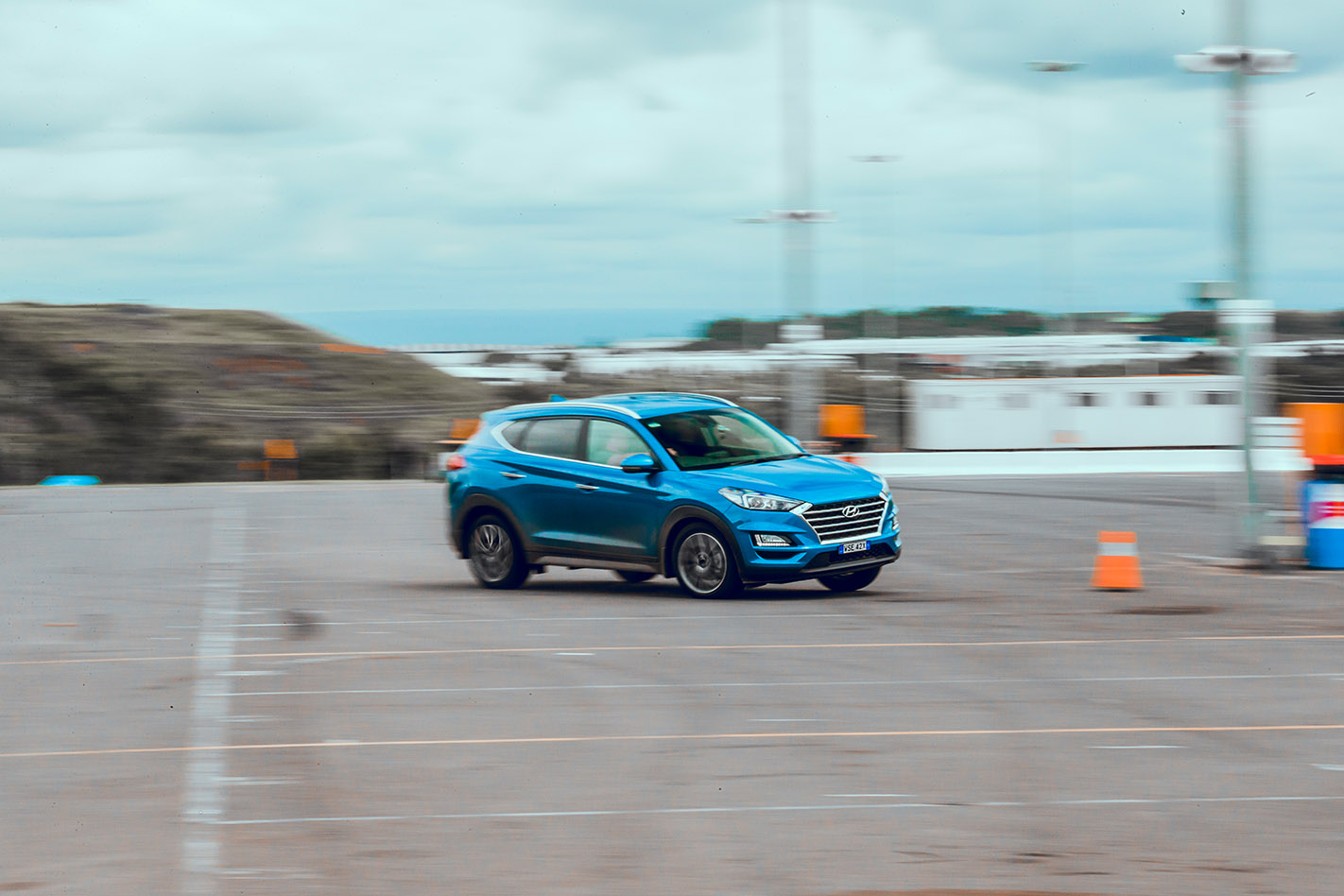
Test #5: Wet braking
The threat of rain during our day of testing turned out to be a blessing in helping keep one section of the road surface consistently damp. Wind and sun are not conducive to a wet track.
“Every time I arrived it was exactly the same,” said Renato, praising the water truck that made a sweep minutes before each run.
As with the dry, the wet braking runs start at 110km/h so the ABS is pulsing through 100km/h. Data collected by the VBox then gives us a precise stopping distance.
Some tyres nearly matched their dry stopping time in the wet – such as the Maxxis and Continental PremiumContact – although we use different parts of the facility for the respective tests, so wet-versus-dry comparisons aren’t easy. Best focus on how each tyre compared against its rivals.
And it’s on a slippery surface that some tyres start to come undone. The difference between best and worst was 12.4 metres, or almost three Tucsons nose-to-tail. Put it down to compound, difference in tread pattern and how well the grooves handle standing water.
Not that all tyres relied entirely on that wet bitumen. The Hankook was the only tyre to sail past the wet area and touch the edge of the dry bitumen with the front wheels. A full 52 metres from the 100km/h speed to the point at which the car was stationary.
“They had pretty average wet weather performance,” was Renato’s somewhat understated assessment.
The Cooper was better but still below par. “It went sailing past all the barriers,” said Renato of the water bollards that made handy visual markers of performance.
The Kumho was similarly lacking in wet longitudinal grip, while the Toyo lacked the stopping prowess it had displayed in dry cornering moments earlier.
“They didn’t amaze me in the wet weather braking,” said Renato.
The Continental UltraContacts had the feel and control – “there were short, fast ABS pulses, so the tyre was recovering very quickly” – but it ran mid-pack, taking a full 45 metres to pull up from triple figures. It’s a rare blip on an otherwise impressive scorecard.
| Rank | Tyre | Distance | Score |
| 1 | Maxxis Premitra 5 | 39.64 | 100 |
| 2 | Continental PremiumContact 6 | 40.32 | 98.3 |
| 3 | Bridgestone Ecopia H/L001 | 41.46 | 95.4 |
| 4 | Hifly Vigorous HP801 | 41.94 | 94.2 |
| 5 | Continental UltraContact UC6 SUV | 45.04 | 86.4 |
| 6 | Toyo Proxes C100 Plus SUV | 46.52 | 82.6 |
| 7 | Giti Control SUV880 | 46.68 | 82.2 |
| 8 | Kumho Crugen Premium | 47.62 | 79.9 |
| 9 | Cooper CS5 Grand Touring | 48.28 | 78.2 |
| 10 | Hankook Dynapro HP2 | 52.05 | 68.7 |
Wet braking winner: Maxxis Premitra 5
If its dry stopping wasn’t impressive enough, its wet performance stepped it up to proclaim the Maxxis Premitra 5 the king of braking in 2020. It was the only tyre to arrest 1.6 tonnes of Tucson in less than 40m of wet bitumen, and just 64cm shy of its dry marker. Another strong outing took second for the Continental PremiumContact 6, with Bridgestone filling out the podium.
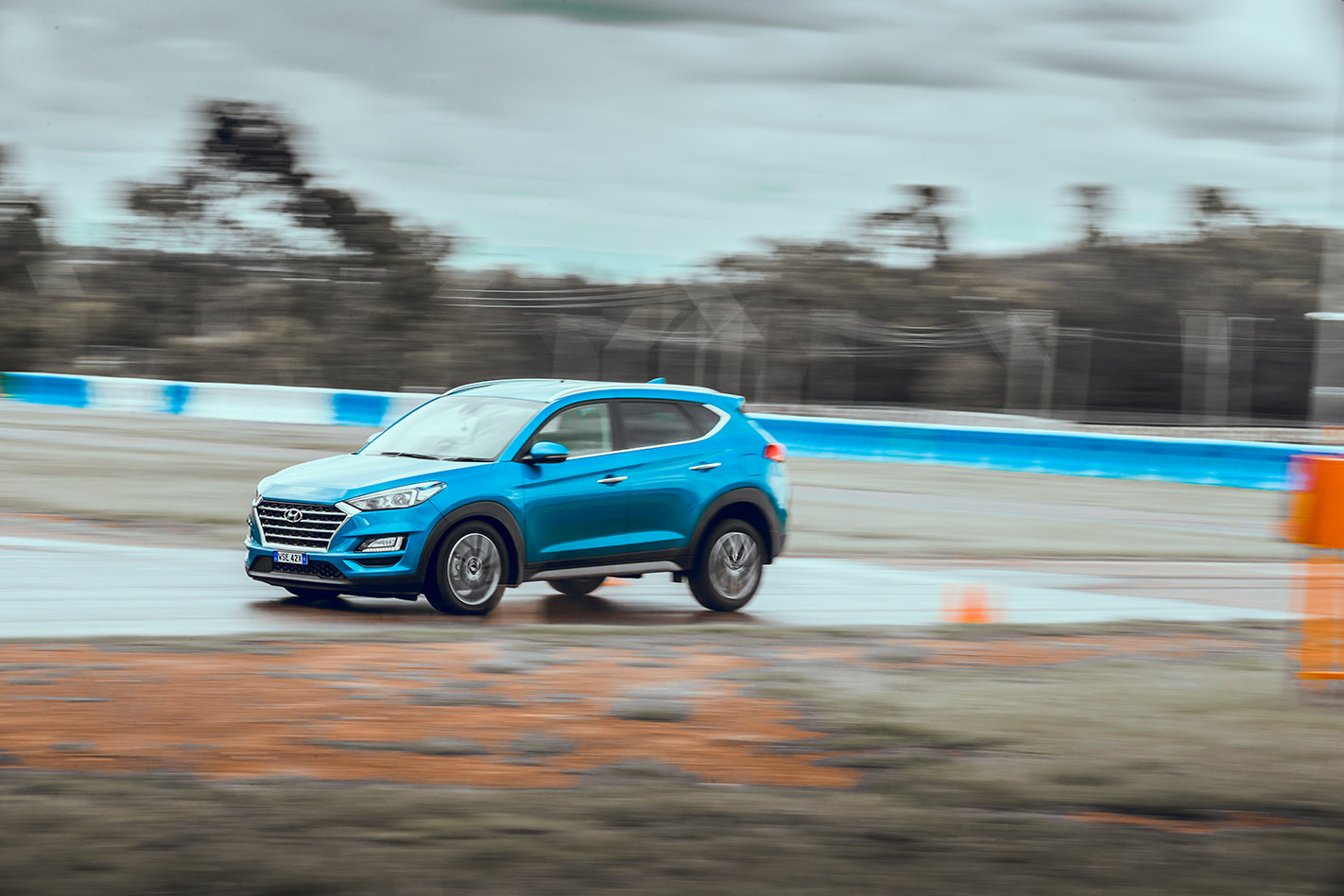
Test #6: Wet cornering
“It was the first cone down!” said Renato excitedly after pushing just that bit too hard through one of our two wet corners. The Tucson was still pointing in the right direction, but an orange cone had a few more black marks down its side.
Ultimately tyre compound and tread pattern can make a huge difference, even if there are compromises elsewhere, as the Maxxis proved. What it lacked in stability in dry cornering it made up for with grip on a slippery surface. Renato also praised its consistency despite some apparent flex in the sidewall.
Whereas the weight and height of the Tucson proved a challenge with 1G peaks in the dry, they were less of an issue when the G forces were wound back to around 0.8/0.9G in the wet.
Almost as quick and with way more feel was the Continental PremiumContact, which just “did everything really well … from a feel and driver point of view”.
Despite average wet braking, the Cooper bit well into wet bitumen when cornering. Consistent and predictable, it matched the ContiPremiumContact for traction through our wet bends. Even though the Cooper finished a hundredth of a second behind the Conti UltraContact, Renato was moved to say the Cooper was “super impressive in the way it went to understeer in the wet”. Never before has understeer been so enjoyable…
It was the Hifly rubber that threw up the biggest surprise. After a strong performance in the wet braking exercise, its softer compound saw it notch up another impressive result here to finish just outside the podium places. The Toyo didn’t cover itself in glory by finishing eighth, though Renato was positive about its ability to be thrown around in the wet.
There was no hiding with the Kumho, which reached its grip limits early and saw Renato battling with lengthy skating. It was a clear wooden spooner, though the marginally better Hankook was described as “very vague”.
“I tried to push it a couple of percent harder on the way in and it gave me nothing back,” said Renato. Except a flying cone.
| Rank | Tyre | Time | Score |
| 1 | Maxxis Premitra 5 | 6.90 | 100 |
| 2 | Continental PremiumContact 6 | 6.96 | 99.1 |
| 3 | Cooper CS5 Grand Touring | 6.96 | 99.1 |
| 4 | Continental UltraContact UC6 SUV | 6.97 | 99.0 |
| 5 | Hifly Vigorous HP801 | 7.03 | 98.1 |
| 6 | Giti Control SUV880 | 7.07 | 97.5 |
| 7 | Bridgestone Ecopia H/L001 | 7.11 | 97.0 |
| 8 | Toyo Proxes C100 Plus SUV | 7.12 | 96.8 |
| 9 | Hankook Dynapro HP2 | 7.35 | 93.5 |
| 10 | Kumho Crugen Premium | 7.43 | 92.3 |
Wet cornering winner: Maxxis Premitra 5
Here at Wheels we like surprises, and that’s exactly what the Maxxis delivered when things got wet. Through our two soggy corners it edged out all contenders to prove sheer grip counts for plenty. There were matching times for the Continental PremiumContact 6 and the Cooper, which were joint runners-up. The second set of Continentals missed the top three by the narrowest of margins.
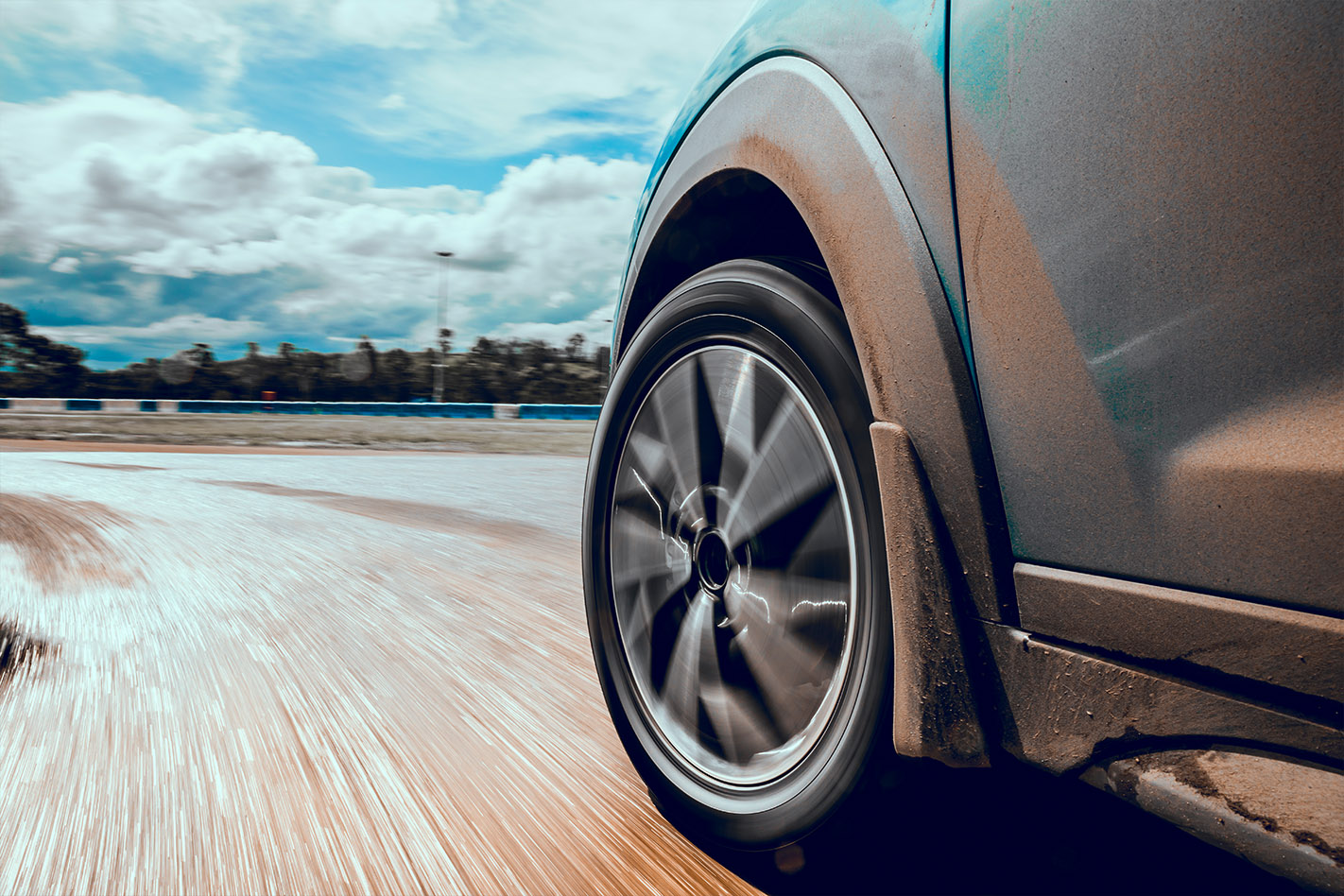
Test #7: Tyre noise
Big distances can lead to big frustration on good ol’ Aussie coarse-chip bitumen if the tyres you’re rolling on send too much white noise back into the cabin. It’s a problem for manufacturers, who don’t want frustrated customers rushing back to dealerships to tell them the car is unbearable.
So it’s perhaps no surprise that the Nexen N’priz RH7 fitted standard to our Tucson, but not included in our field, aced the noise test. At 80km/h the noise into the cabin peaked at 58.5dB, according to our Digitech sound meter. That was better than all 10 of our contenders by at least 0.7dB. Granted, the short strip at the base of the Sydney Dragway car park is a long way from the rolling Hay Plains, but it gives us a comparative guide as to how they’ll perform on longer trips and at higher speeds.
Of course, road noise is only one component of overall tyre noise. The other is how they perform under load. It was here Renato noticed some big differences. Each of the Contis kept things fairly quiet, while the Maxxis and the Cooper were eager to let anyone within a couple of postcodes know you’re misbehaving.
| Rank | Tyre | Noise level | Score |
| 1 | Continental PremiumContact 6 | 59.2 | 100 |
| 2 | Bridgestone Ecopia H/L001 | 59.2 | 100 |
| 3 | Cooper CS5 Grand Touring | 59.2 | 100 |
| 4 | Hifly Vigorous HP801 | 59.4 | 99.7 |
| 5 | Continental UltraContact UC6 SUV | 59.5 | 99.5 |
| 6 | Kumho Crugen Premium | 59.5 | 99.5 |
| 7 | Toyo Proxes C100 Plus SUV | 60.1 | 98.5 |
| 8 | Hankook Dynapro HP2 | 60.1 | 98.5 |
| 9 | Giti Control SUV880 | 60.2 | 98.3 |
| 10 | Maxxis Premitra 5 | 60.3 | 98.1 |
Tyre noise winner: It’s a three-way tie!
Joint winners with a decibel peak of 59.2 were the Continental PremiumContact 6, the Bridgestone and the Cooper. That two of these – the Bridgestone and the Continental – finished in the top three overall is testament to engineering that prioritises liveability as well as grip.
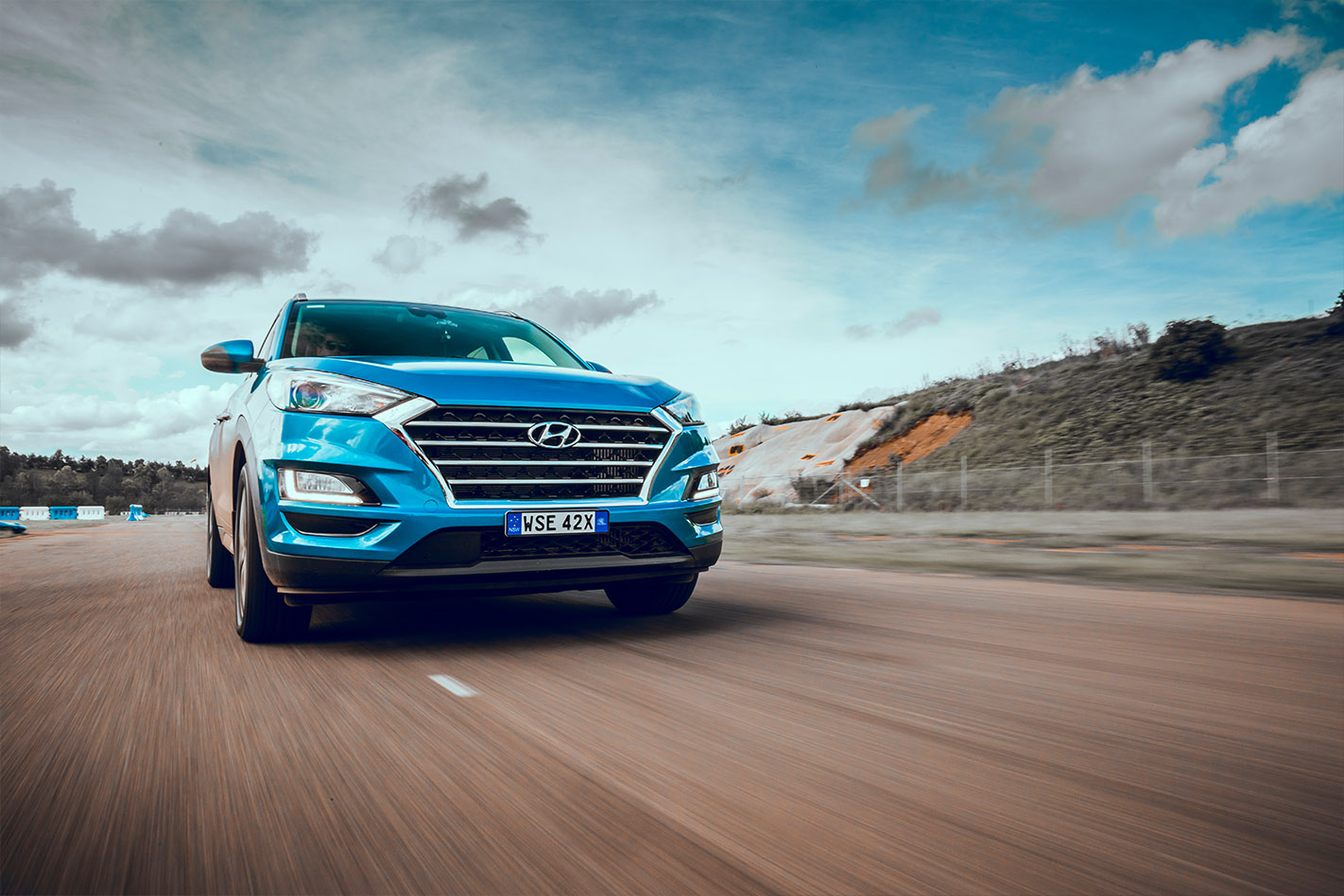
2020 Wheels tyre test overall winner: Continental PremiumContact 6
Excelling in one or two disciplines isn’t enough in a tyre test. Consistency is key to keeping our contenders up towards the pointy end of the field. It was that consistency that earned the Continental PremiumContact 6 the top step on the podium. It only led the field in two categories – dry cornering and noise levels – but it finished second (often closely) in the remaining four, giving it a scorching 99.3 percent score, nearly three percent above runner-up Maxxis. It was a tyre that impressed Renato from the first twirl of the wheel.
“That felt like the best tyre by some margin … it did everything really well,” he noted. “Super consistent everywhere.”
That it sells for $260 a tyre confirms the PremiumContact as premium rubber, albeit one that – anecdotally – could wear quicker than some alternatives. It was also a far more convincing all-rounder than our champion stopper, the Maxxis Premitra 5. If it weren’t for lacklustre dry cornering, the Maxxis could have scored an upset.
Similarly, it was dry cornering that proved the undoing of the third-placed Bridgestone Ecopia H/L001. The second of the Continentals, the UltraContact UC6 SUV, had the feel and some impressive cornering nous but shed crucial points stopping in the wet. The UC6 SUV being more expensive than the other Continental makes it an easy choice.
The mid-pack trio consisted of the Cooper CS5 Grand Touring, Hifly Vigorous HP801 and Giti Control SUV880. Curiously, all hung on stubbornly through wet corners, but fell short in other disciplines; the Cooper and Giti in wet braking and the Hifly in dry cornering.
Consistency was a trait of the Kumho Crugen Premium – consistently subpar. “Feels like an 80 percent all-rounder,” Renato declared.
Cellar-dweller the Hankook Dynapro was okay when it came to cornering performance but fell down on braking. At $310 per hoop from a company that’s delivered big improvements over recent years we expected more.
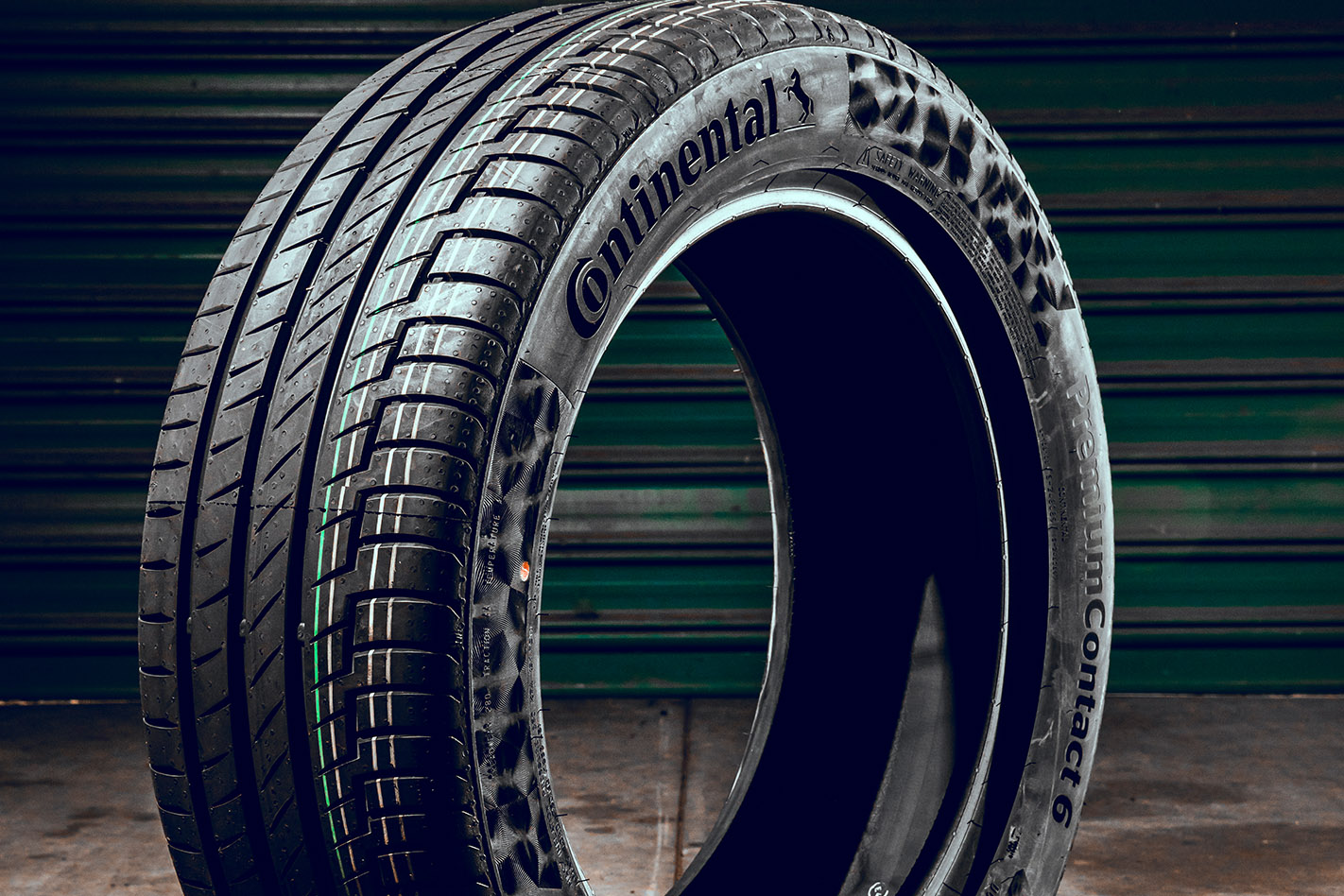
2020 Wheels tyre test overall ranking
| Rank | Overall | Score | Price |
| 1 | Continental PremiumContact 6 | 99.3 | $260 |
| 2 | Maxxis Premitra 5 | 96.9 | $240 |
| 3 | Bridgestone Ecopia H/L001 | 95.8 | $350 |
| 4 | Continental UltraContact UC6 SUV | 95.5 | $290 |
| 5 | Toyo Proxes C100 Plus SUV | 94.1 | $270 |
| 6 | Cooper CS5 Grand Touring | 93.7 | $294 |
| 7 | Hifly Vigorous HP801 | 93.3 | $160 |
| 8 | Giti Control SUV880 | 93.1 | $255 |
| 9 | Kumho Crugen Premium | 90.4 | $200 |
| 10 | Hankook Dynapro HP2 | 88.2 | $310 |

